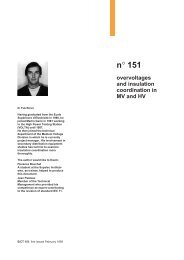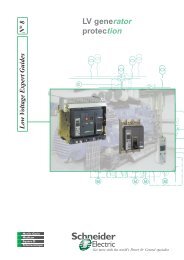sepam 20 user manual - Schneider Electric
sepam 20 user manual - Schneider Electric
sepam 20 user manual - Schneider Electric
Create successful ePaper yourself
Turn your PDF publications into a flip-book with our unique Google optimized e-Paper software.
Use Default parameter setting<br />
The Sepam units are delivered with default parameter<br />
setting and protection setting according to the type of<br />
application.<br />
These "factory" settings are also used with the<br />
SFT 2841 software:<br />
b for the creation of new files in disconnected mode<br />
b for a return to the "factory" settings in connected<br />
mode.<br />
PCRED301005EN - 06/<strong>20</strong>08<br />
S<strong>20</strong>, S23, T<strong>20</strong>, T23, M<strong>20</strong> applications<br />
Hardware configuration<br />
b Identification: Sepam xxxx<br />
b Model: UX<br />
b MES module: absent<br />
b MET module: absent<br />
b MSA module: absent<br />
b DSM module: present<br />
b ACE module: absent.<br />
Output parameter setting<br />
b Outputs used: O1 to O4<br />
b Shunt trip units: O1, O3<br />
b Undervoltage trip units: O2, O4<br />
b Impulse mode: no (latched).<br />
Program logic<br />
b Circuit breaker control: no<br />
b Logic discrimination: no<br />
b Logic input assignment: not used.<br />
General characteristics<br />
b Network frequency: 50 Hz<br />
b Group of settings: A<br />
b Enable remote setting: no<br />
b Working language: English<br />
b CT rating: 5 A<br />
b Number of CTs: 3 (I1, I2, I3)<br />
b Rated current In: 630 A<br />
b Basic current Ib: 630 A<br />
b Integration period: 5 min<br />
b Residual current: 3I sum<br />
b Pre-trig for disturbance recording: 36 periods.<br />
Protection functions<br />
b All the protection functions are "Off"<br />
b The settings comprise values and choices that are informative and consistent with<br />
the general default characteristics (in particular rated current In)<br />
b Tripping behavior:<br />
v latching: yes (except for functions 50BF, 49RMS, 37 and 66)<br />
v activation of output O1: yes (except for functions 50BF and 66)<br />
v disturbance recording triggering: with (except for functions 50BF, 48/51LR and<br />
66).<br />
Control matrix<br />
Each Sepam has default program logic according to the type (S<strong>20</strong>, T<strong>20</strong>, etc.) as well<br />
as messages for the different LEDs.<br />
The functions are assigned according to the most frequent use of the unit. This<br />
parameter setting and/or marking can be customized if required using the SFT 2841<br />
software tool.<br />
b S<strong>20</strong> application:<br />
v activation of output O2 upon protection tripping<br />
v activation of LEDs according to front panel markings<br />
v watchdog on output O4<br />
v disturbance recording triggering upon signal pick-up<br />
b Additional functions for T<strong>20</strong> application:<br />
v activation of O1 without latching upon tripping of temperature monitoring 1 to 7<br />
v activation of O1 and LED L9 without latching upon thermal overload tripping<br />
b Additional functions for M<strong>20</strong> application:<br />
v activation of outputs O1 and O2 and LED L9 upon tripping of functions, 37 (phase<br />
undercurrent) and 51LR (locked rotor)<br />
v activation of output O2 upon tripping of function 66 (starts per hour)<br />
v latching for function 51LR<br />
b Complement for S23, T23 applications:<br />
All functions, except for 49 RMS, activate the 50BF protection function in the<br />
absence of circuit breaker control.<br />
7/19<br />
7

















